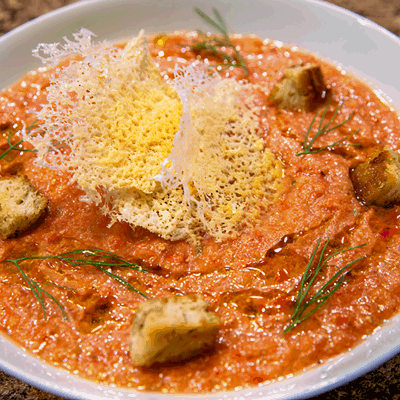
Shall I compare thee to a summer’s day? Beautiful, refreshing, colorful — wait a minute. I’m fantasizing about spring rolls again.
Nothing says summer to me quite like a spring roll. They originate from Southeast Asia, a large area of rich cultures and fabulous cuisine. In countries like Thailand and Vietnam, the people have mastered complex flavors using diverse ingredients.
This is my spin on something I grew up eating, using materials available here in our area. If you’re wanting to impress your friends, vegan or otherwise, sharpen your knife skills by making cool and crunchy spring rolls just in time for the summer heat. Not to mention, these rainbow snacks are the perfect way to wrap up Pride month.
It’s hard to imagine cooking a hot meal in a hot kitchen on a hot day.
This dish requires the least amount of cooking possible, so you can spend less time hovering over a stove or grill and more time cooling off with friends and family. Spring rolls work wonderfully for picnics, potlucks and barbecues and may be the perfect way to freshen up a classic Fourth of July spread. Make them up to a day in advance and enjoy the perfect marriage between flavor and texture.
Spring Rolls (yields 16; serves 4)
Prep time: 15 min
Cook time: 5 min
Assembly time: 20 min
Total time: 40 min
Ingredients:
- 16 rice paper rounds
- 1 large carrot, julienned
- 1 red bell pepper, julienned
- ½ cup red cabbage, finely shredded
- 1 seedless cucumber, julienned
- 8 basil leaves, bisected lengthwise
- 4 scallions, sliced on the diagonal
- 8 ounces vermicelli or glass noodles
- Cilantro leaves (optional)
- 8 mint leaves, bisected lengthwise (optional)
- 8 leaves butter lettuce bisected lengthwise (optional)
- Steamed shrimp, sliced tofu or sliced omelet (optional)
Dipping Sauce Two Ways
For peanut sauce:
- ¾ cup chunky peanut butter
- 2 tablespoons hoisin sauce
- 2 teaspoons fish sauce*
- 1 tablespoon Sriracha (optional)
- 2 tablespoons sweet chili sauce (a terrific dipping sauce on its own)
- 1-2 tablespoons warm water, to thin sauce
- 1 lime, juiced
For soy lemon garlic sauce:
- ¼ cup soy sauce
- 2 tablespoons rice vinegar
- 1 lemon, juiced
- 3 garlic cloves, finely minced
*If serving vegans, use vegan fish sauce, tamari or coconut aminos in the peanut sauce. Fish sauce is the salt/umami component, so be sure to taste for salt if opting for an alternative.
Supplies:
- A sharp chef’s knife, Santoku knife or cleaver
- A large cutting board
- Lipped plate or wide, shallow bowl
Directions:
Start by cutting all vegetables and herbs accordingly and group them on a platter set to the side. If including a protein such as shrimp or omelet, prepare this step now so it has time to cool to room temperature. If preparing steamed shrimp, bisect along the back to create two thinner shrimp pieces. Boil water for the noodles. Typically, glass noodles or vermicelli just need to soak in hot water for a few minutes. Cook the noodles according to the package, drain and set aside to cool. Once all fillings are ready, wipe off the cutting board and moisten with cold water.
To a shallow bowl or plate, add cold water. Dip the rice paper into the water quickly and then lay it flat on the moistened cutting board. It should still be stiff but will continue to soften on the board. Begin to assemble the spring rolls, starting with a small amount of noodles. If including lettuce, start with that, then layer everything else on top. Add a few pieces of each vegetable, some herbs and the protein.
It’s important to note that whatever you want shown from the outside must be added last after you’ve begun to roll. For example, if you want the shrimp to show, add it right before you finish rolling so it shows beneath the translucent rice paper. The rice paper will be somewhat sticky, so once it’s rolled it seals itself. Set to the side and be mindful rolls will try to stick to one another.
Where to Find:
- Sriracha, hoisin, sweet chili sauce, fish sauce, noodles and rice paper: The Asian section of your grocery store is host to so many fabulous ingredients. If you opt for all those listed, you will have a plethora of delicious ingredients in your fridge that will last you some time.
- Shrimp: Fresh and cooked shrimp can be found in the fish section of the meat counter. If opting for precooked shrimp, thaw thoroughly before using. If using raw shrimp, steam or boil for 2 minutes and cool thoroughly before using.
- Tofu: Tofu, or soy curd, will be found in a refrigerated section of the grocery store, typically housed near plant-based options or the organic and specialty foods section.
Takeaway Tips:
Julienne is a knife technique used to create uniform “matchsticks” out of your vegetables. Typically, vegetables cut with this technique are very thin, between 2 and 3 inches long, and resemble matches. An easy method for cutting vegetables such as carrots or cucumbers this way is to slice vegetables on the diagonal to create the desired length, then thinly cut the slices lengthwise.
Don’t get too ambitious when portioning out the fillings, or you won’t be able to roll them up. This recipe can yield anywhere from 10 to 24 spring rolls, depending on the size of your veggies and how many rice paper rounds come in a package. Start small, using only 3 to 4 pieces of each vegetable until you find what works. That being said, this recipe can be easily doubled or tripled.
Any leftover fillings can be combined with either dipping sauce to create a crunchy salad.
If making in advance, keep in an airtight container in the fridge. Since rolls are lightweight, they stack well, but separate each layer with plastic wrap or parchment paper so they don’t stick together.
As always, experiment with what you like. If you want fewer vegetables and more protein, opt for a shrimp spring roll using just herbs, lettuce and noodles. If you prefer fewer noodles, replace them with more vegetables or leave them out entirely. With a wide variety of fillings at your disposal, the combinations are endless.
Winn is a home cook and an eat-the-rainbow advocate. She can be reached at @food_for_winners on Instagram or at madisonwinncooks@gmail.com.























